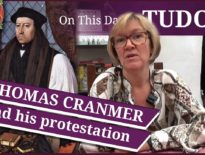On this day in Tudor history, 29th March 1555, in the reign of Queen Mary I, Protestant and former Dominican priest, John Laurence, was burned at the stake for heresy in Colchester.
At his burning, young children encouraged him with their prayers.
Find out more about his John Laurence's sad end in today's talk.
Also on this day in Tudor history, 29th March 1551, Mary Dudley, eldest daughter of John Dudley, Duke of Northumberland, married Henry Sidney. Find out more about them, and also how Mary suffered so terribly with smallpox after nursing Queen Elizabeth I, in last year’s video:
Also on this day in history:
- 1564 – Death of Sir Edmund Peckham, Privy Councillor in Mary I's reign, and High Treasurer of all the mints from 1544. He was buried at Denham Church in Buckinghamshire.
- 1591 – Burial of William Wager, playwright and Church of England clergyman, at the church where he was Rector, St Benet Gracechurch. His plays included “Enough is as Good as a Feast” and “The Longer thou Livest the More Fool thou art”, both polemical Protestant interludes.
- 1613 – Burial of Sir Thomas Bodley, scholar, diplomat, and founder of the Bodleian Library, Oxford. He was laid to rest in Merton College Chapel, Oxford.
- 1628 – Death of Tobie Matthew, Archbishop of York, at Cawood. He was buried in York Minster. Matthew had become Bishop of Durham in 1595, and then Archbishop of York in 1606.
Transcript:
On this day in Tudor history, 29th March 1555, in the reign of Queen Mary I, former Dominican priest and Protestant martyr, John Laurence, was burned at the stake as a heretic in Colchester.
Laurence, along with fellow martyrs William Pygot and Stephen Knight, was interrogated by Edmund Bonner, Bishop of London. When he was asked his opinion of the sacrament of the altar, the Eucharist, he said that it was “a remembrance of Christ's body, and that many have been deceived in believing the true body of Christ to be in the sacrament of the altar: and that all such as do not believe as he doth, do err.” Laurence also stated that he had been a priest for 18 years, that he’d been a black friar, and that he was due to marry. He and his fellow prisoners were exhorted to recant and to turn back to the Catholic faith, but they refused. They were condemned for heresy, imprisoned in Newgate, where, according to martyrologist John Foxe, “they remained with joy together until they were carried down into Essex”. N 28th March, Pygot was executed at Braintree and Knight was executed at Malden.
On this day in Tudor history, 29th March 1555, John Laurence was carried to the stake at Colchester. According to Foxe, he had to be carried in a chair because “his legs were sore worn with heavy irons in the prison, as also his body weakened with evil keeping.” Foxe records that children were present at his burning, writing:
“At the burning of this Laurence, hee sitting in the fire the young children came about the fire, and cryed, (as wel as young children could speake) saying: Lorde strengthen thy seruaunt, and keepe thy promise, Lord strengthen they seruaunt, and keepe thy promise.”
I can’t quite imagine taking children to see someone being burned at the stake, but Foxe thought their behaviour was very appropriate, writing that it was rare and that it was “no small manifestation of the glory of God, who wrought this in the hearts of these little ones; nor yet a little commendation to their parents, who, from their youth, brought them up in the knowledge of God and his truth.”
So, that was the end of former priest and Protestant John Laurence.



Leave a Reply